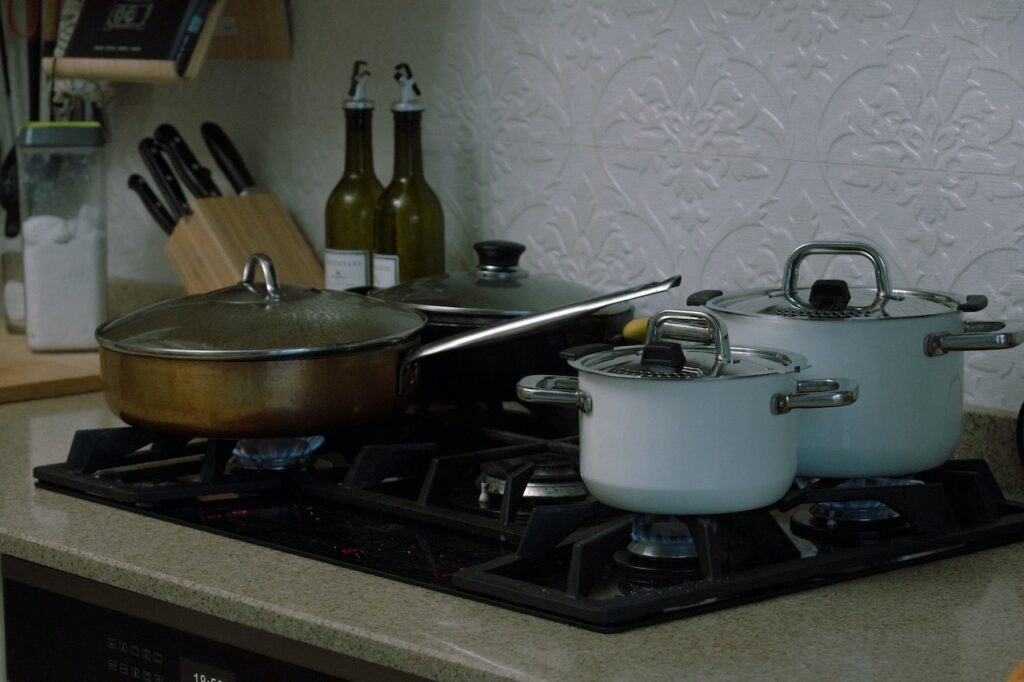Cooking is an art, and like any artist, you need the right tools to create your culinary masterpieces. In the world of cooking, your pots and pans are your paintbrushes and canvas, allowing you to craft delicious dishes that delight the senses. If you’re ready to build the perfect pots and pans collection, this guide will walk you through the essentials, helping you make informed choices and elevate your cooking game.

Understanding the Basics
Before we dive into the specifics, it’s important to understand the basic types of pots and pans you’ll encounter in your culinary journey:
1. Skillet or Fry Pan
A versatile kitchen workhorse, the skillet is ideal for sautéing, searing, and frying. You’ll use it for everything from omelets to stir-fries. Look for a skillet with a flat bottom and sloping sides to maximize cooking surface area.
2. Saucepan
Saucepans come in various sizes and are perfect for making sauces, boiling water, or reheating leftovers. Choose a set with different-sized saucepans to cover a range of cooking needs.
3. Stockpot
Stockpots are large, deep pots with tall sides, making them ideal for cooking soups, stews, and pasta. A good stockpot is a must-have for batch cooking or preparing meals for a crowd.
4. Dutch Oven
A Dutch oven is a heavy, lidded pot that can go from stovetop to oven. It’s excellent for slow-cooking braises, roasts, and one-pot dishes. Cast iron Dutch ovens are renowned for their heat retention and even cooking.
5. Nonstick Pan
A nonstick pan is essential for cooking delicate foods like eggs and fish. It requires less oil and is easy to clean. However, be gentle with it, as nonstick coatings can wear out over time.
Building Your Collection
Now that you know the basics, let’s discuss how to build the perfect pots and pans collection:
1. Start with a Set
For beginners, a cookware set is an excellent way to kickstart your collection. Look for sets that include a variety of pots and pans, including a skillet, saucepan, and stockpot. This provides a solid foundation for your cooking adventures.
2. Invest in Quality
Quality cookware is an investment that pays off in the long run. Consider materials like stainless steel, cast iron, or copper-clad for durability and even heating. These materials are less prone to warping or developing hot spots.
3. Consider Nonstick
While not suitable for all cooking tasks, a nonstick skillet is invaluable for certain dishes. Make sure to choose a reputable brand with a durable nonstick coating.
4. Add Specialty Pans
As you progress, add specialty pans to your collection. Consider a wok for stir-fries, a roasting pan for holiday dinners, and a grill pan for indoor grilling. These pans cater to specific cooking styles and expand your culinary repertoire.
5. Don’t Forget the Lids
Lids are often overlooked but are crucial for retaining heat and moisture. Ensure your collection includes lids that fit your pots and pans snugly.
6. Mix and Match
Your pots and pans don’t need to be from the same brand or set. Mixing and matching allows you to curate your collection based on your cooking preferences. Just ensure that the materials and sizes complement each other.
Caring for Your Cookware
To make your pots and pans last a lifetime, proper care is essential:
- Hand wash when possible: While some cookware is dishwasher-safe, hand washing is gentler on your pots and pans, preserving their finish.
- Use appropriate utensils: Avoid metal utensils in nonstick pans, as they can damage the coating. Opt for wood, silicone, or plastic utensils instead.
- Season your cast iron: If you have cast iron cookware, learn how to season it to maintain its nonstick properties and prevent rust.
- Store with care: To prevent scratches and damage, stack your pots and pans with protective padding in between or hang them on a pot rack.
Building the perfect pots and pans collection is a journey that enhances your culinary skills and opens up a world of cooking possibilities. Remember that the best pots and pans for you are the ones that suit your cooking style and needs. So, start with the basics, invest in quality, and gradually expand your collection as your skills and passion for cooking grow. With the right tools in your kitchen, you’re well on your way to creating culinary masterpieces that will impress family and friends for years to come. Happy cooking!